| Srl | Item |
| 1 |
ID:
132005
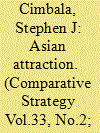

|
|
|
|
|
| Publication |
2014.
|
| Summary/Abstract |
The United States' military-strategic pivot toward Asia is motived by concerns about a rising China, about the increased significance of Asia on the world economic and political stages, and about the growing risks of nuclear proliferation and nuclear first use in that region. Nuclear Asia already numbers five acknowledged or de facto nuclear weapons states among its members: Russia, China, North Korea, India, and Pakistan. Failure to reverse North Korea's nuclear weapons status or political distrust among other powers may increase the number of Asian nuclear weapons states (including states with prospective nuclear-missile reach into Asia) to eight, creating an Asian-Middle Eastern nuclear arms race that defies containment. On the other hand, an alternative presents itself, in the form of a multilateral nuclear arms reduction agreement that would create three tiers of accepted nuclear weapons states and bar the door to new admits.
|
|
|
|
|
|
|
|
|
|
|
|
|
|
|
|
| 2 |
ID:
132004
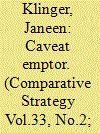

|
|
|
|
|
| Publication |
2014.
|
| Summary/Abstract |
Although intuitively social science has much to contribute to strategy, this article examines the difficulty for strategists doing so. To illustrate the difficulty, the article draws on two social science theories that provided conceptual frameworks for U.S. strategy in the 1960s: deterrence/coercion theory and modernization theory. The article also draws on the cases of Project Camelot in the 1960s and the recent use of human terrain teams to illustrate the difficulty encountered by the military when it tries to use social scientists operationally.
|
|
|
|
|
|
|
|
|
|
|
|
|
|
|
|
| 3 |
ID:
132003
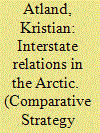

|
|
|
|
|
| Publication |
2014.
|
| Summary/Abstract |
The five states that surround the Arctic Ocean- Russia, Canada, the United States, Denmark, and Norway-have in recent years taken various measures to protect their economic and security interests in the north. The measures include not only the adoption of Arctic strategies, but also the development of new military capabilities. As in other parts of the world, one state's military efforts to enhance its security may have the unfortunate effect of making others feel less secure, and therefore more likely to undertake similar efforts. Thus, despite being a low-tension region, the Arctic is by no means immune to the logic of the security dilemma.
|
|
|
|
|
|
|
|
|
|
|
|
|
|
|
|
| 4 |
ID:
132001


|
|
|
|
|
| Publication |
2014.
|
| Summary/Abstract |
This article examines the merits of extending the U.S. nuclear deterrent to the Middle East. It begins by looking at past practices of such an extension before delving into the overall issues presented by providing such a security guarantee. This article then looks at a brief survey of some of the regional issues facing a nuclear extension before considering the P-5 states and their concerns.
|
|
|
|
|
|
|
|
|
|
|
|
|
|
|
|
| 5 |
ID:
132000
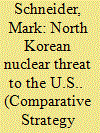

|
|
|
|
|
| Publication |
2014.
|
| Summary/Abstract |
A recent unclassified Defense Intelligence Agency (DIA) assessment stated: "DIA assesses with moderate confidence the North [Korea] currently has nuclear weapons capable of delivery by ballistic missiles." This conclusion is highly credible and not really new. North Korea was assessed to have nuclear weapons long before the actual (or at least detected) first test of these weapons in 2006. Building a nuclear weapon small enough to be carried by the relatively large payloads of North Korea's ballistic missiles is not a very difficult task today. In light of what is now known about the proliferation of a nuclear missile warhead from China to Pakistan and from Pakistan to North Korea, the North Korea defector reports about nuclear weapons development and the North Korean nuclear tests, the DIA conclusion may be an understatement. The North Korean nuclear stockpile may be significantly greater than what is usually assessed. This is of concern because the North Korean regime is the most brutal Stalinist dictatorship in the world. Moreover, while North Korea has long made occasional nuclear attack threats against the U.S. in the past, the scope, magnitude, and frequency of these threats vastly increased in 2013. Current U.S. policy, which downgrades the importance of nuclear deterrence and cuts missile defense, is not well suited to handle this threat.
|
|
|
|
|
|
|
|
|
|
|
|
|
|
|
|
| 6 |
ID:
132002
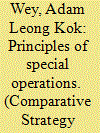

|
|
|
|
|
| Publication |
2014.
|
| Summary/Abstract |
The principles espoused in Sun Tzu's Art of War and Sextus Iulius Frontinus's Stratagematon that have linkages with the practice of special operations warfare are examined in this article. The academic study of special operations within the field of strategy has been hindered by the lack of resources in strategic theories that explain how special operations work and succeed. This article presents the discovery of principles of special operations which has been vividly described in both of these classical texts but often overlooked, and these principles can be matched with the contemporary practice of special operations.
|
|
|
|
|
|
|
|
|
|
|
|
|
|
|
|